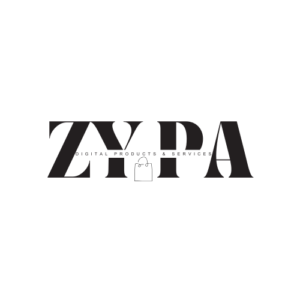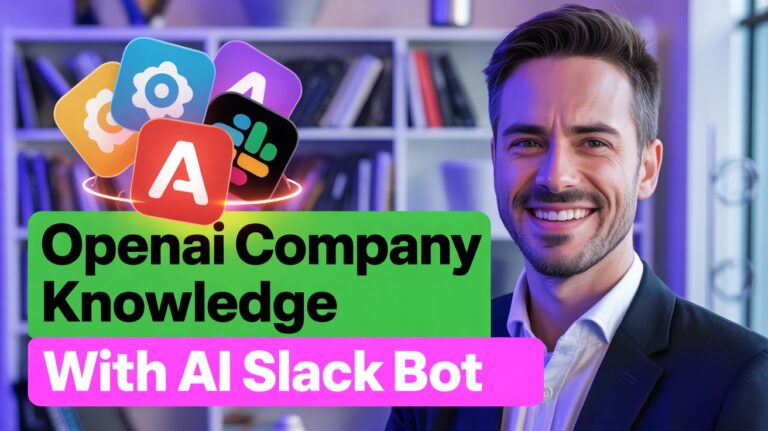Tesla’s AI roadmap, which goes from AI5 to AI8, was just unveiled by Elon Musk, and it represents the most rapid advancement in self-driving technology to date. Full Self-Driving (FSD) has always been a frantic race full of audacious claims and annoying hold-ups. Is complete autonomy just a software update away, or is it a far-off dream? We’ve been watching a “beta” product gradually get better for years.This new Tesla AI5 to AI8 roadmap, however, is not the same. This has nothing to do with little lane-keeping adjustments. A clear path from a video-trained FSD to a possible Artificial General Intelligence (AGI) is revealed by this fundamental rewriting of autonomous driving.

This is more than simply a car narrative for other creators, marketers, and tech entrepreneurs. It’s a real-life case study on disruption, data-driven expansion, and creating a product for a market that isn’t quite there yet. So fasten your seatbelt. Let’s examine the implications of the Tesla AI5 to AI8 roadmap for the future of, well, everything.
The FSD Revolution → Why This Tesla AI5 Roadmap Is Revolutionary
Tesla’s FSD was a complicated beast prior to AI5, which powered the new FSD V12. Over 300,000 lines of C++ code—a conventional, “if-this, then-that” rules-based system—were purportedly used to run it. For almost every circumstance, engineers had to manually code logic: “If the light is red, stop.” “If a pedestrian is here, yield.” This system is unscalable and brittle. Every strange occurrence that occurs on a road in Miami or Mumbai cannot be covered by a rule.
Musk’s major wager is that a single end-to-end neural network trained on billions of miles of real-world footage will be able to learn to drive more effectively than any programming created by a person. It learns by observation rather than by rules. It’s the distinction between learning to drive and simply memorizing a driving manual. The methodical approach to transform that AI “brain” from a student driver to a superhuman one is outlined in this new Tesla AI5 to AI8 roadmap.
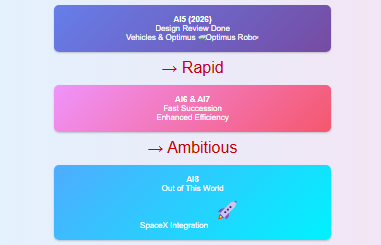
Tesla’s Aggressive Road to Autonomy → The Tesla AI5 to AI8 Roadmap Timeline
This timeframe moves quickly. The AI5 chip production roadmap is not just about the Elon Musk Tesla AI5 chip; it’s about software, data, and computation all developing concurrently.
This condensed schedule demonstrates Tesla’s comprehensiveness. They are attempting to solve generic AI, not simply defeat Waymo.
Also Read: Grokipedia Is Live: Elon Musk’s AI Encyclopedia vs Wikipedia
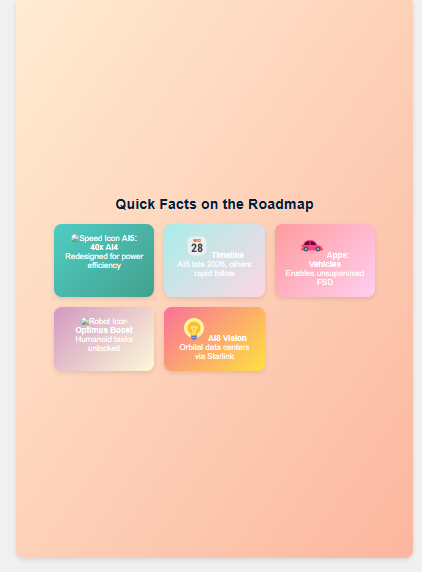
In-depth Analysis → Tesla AI5 to AI8 Roadmap‘s Four Pillars
Let’s examine the true doings of each of these “AI” generations. An exponential curve of competence is produced as each step builds upon the previous one.
AI5 → The ‘End-to-End’ Rewrite (FSD V12)
A single neural network for driving is the “core upgrade.” The basis is Elon Musk Tesla AI5 chip. As previously stated, those 300,000 lines of code are replaced by this version, which is now being released as FSD V12. Consider it this way: The former FSD was a group of experts. One “judges” speed, one “handles” steering, and one “sees” stop signs. They all need to communicate with one another, which increases latency and error risk.
- AI5 (New FSD): One skilled driver. It receives footage from the eight cameras on the vehicle and outputs braking, acceleration, and steering. That’s all. It simply drives. It can manage complicated, unprogrammed situations—like traversing a crowded city street or a hectic construction zone—with a more human-like “feel” because to this single-stack method.
AI6 → The Machine for Scaling (Enter Dojo v2)
Core Upgrade: Dojo v2-powered real-world video training at scale. AI6 is the school that Elon Musk Tesla AI5 chip, the new brain, attends. Scaling the training is the focus of this phase. With millions of vehicles on the road serving as data-gathering robots, Tesla has a distinct advantage. The system designed to handle that flood of video data is called AI6. The secret is Dojo , Tesla’s specially designed supercomputer. Tesla’s next-generation Dojo v2 allows for considerably faster model training. The AI can reprocess all video, learning from both good and bad driving as well as everything in between, rather than only learning from “disengagements” (when a person has to take over).
Develop Your Own Platform as a Creator Growth Tip
Tesla saw that third-party compute (like AWS or Nvidia) was a bottleneck, so they developed their own. This is a powerful lesson from Google’s top creator guides: Own your platform.
As artists, we frequently use borrowed land (social media) to construct our empires. The final objective is to create an audience you own, such as an email list or a personal website, even though we start with the best software for creators and other content creation software. Simply said, Tesla is accomplishing that on a multibillion-dollar scale.
The ‘Real-Time Reasoning’ Engine → AI7
Real-time reasoning and multimodal vision are the core upgrades. The Tesla AI5 to AI8 roadmap becomes genuinely futuristic at this point. The goal of AI7 is to transition from reacting to understanding and predicting. Seeing a pedestrian is insufficient. A system at the AI7 level ought to be capable of:
- Recognize Gestures: Is the traffic cop signaling you to stop or waving you through?
- Fuse Senses: Integrate audio and video. It concludes that an emergency vehicle is approaching from behind after seeing flashing lights and hearing a siren.
- Reason: * “That car is parked illegally, but the driver is in the seat and looking at their mirror. They are about to pull out.” This is what separates a 20-year veteran who can predict an accident three moves ahead from a new driver who passes the exam. In order to navigate the world’s unpredictable and unmapped routes, this stage is essential.
Tesla AI7 Fact Card
Core Concept: AI7 uses multi-modal data processing to achieve real-time reasoning. This implies that it might combine auditory (like a siren) and video (like flashing lights) to make safer, more accurate decisions than a vision-only system.AI8 → The AGI Connection & The “Autonomous Brain”
A generalized “world model” for automobiles and robotics is the “core upgrade.” The endgame is this. AI8 is more of a “general-purpose AI” than a “driving AI” that can be used for driving. Elon Musk AI8 out of this world. The Elon Musk Tesla AI5 chip will be powered by the same “brain” that has mastered world navigation in an automobile (AI8). Real-world physics, text, and video will be used to teach this general, autonomous brain.
It will comprehend context. It will understand more than simply “how to drive to the store”; it will also understand “what a store is,” “why you are going there,” and “how to park and walk inside.” This move is what really sets Tesla’s aspirations apart from those of its competitors. And if they do it perfectly… “If Tesla nails AI8, Google’s Waymo might never catch up.”
Also Read: Atlas ChatGPT Browser Breakdown: OpenAI Atlas vs Google
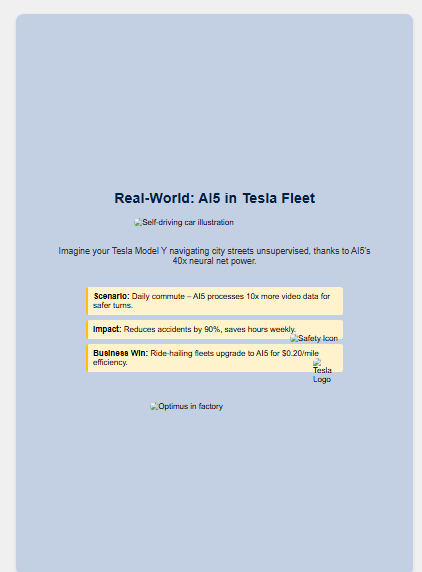
AI5 vs. AI8 Spec Showdown → The Leap in Capability
The scope of Tesla’s ambition is shown in this table. Although several AI8 specifications are anticipated, they are predicated on the logical scaling necessary to achieve the AGI objective.
| Features | AI5 (FSD V12) | AI8 (Projected) |
|---|---|---|
| Primary Task | End-to-End Driving | Generalized Autonomy (Car & Robot) |
| Core Engine | Single Neural Net (Video In/Out) | General Reasoning Engine (AGI) |
| Vehicle Hardware | Hardware 4 (HW4) | Hardware 5/Hardware 6 |
| Compute Power | Optimized for HW4 | 10x-100x+ HW4 Compute |
| Training Data | Billions of miles of video | Trillions of miles (simulation & real-world) |
| Decision Logic | Reactive & Predictive (Driving) | Proactive & Generalized (World Model) |
| Latency | Milliseconds | Near-zero (predictive modeling) |
The Competition → How Does Tesla AI5 Roadmap Compare?
This is not being developed in a vacuum by Tesla. Each of the giants in the quest for autonomy has a distinct ideology. The “Flawless & Fenced-In” driver is Waymo (Google). Waymo makes use of strong LiDAR and high-definition (HD) mapping. Before expanding, it aims to solve driving perfectly in a small, geofenced area (such as Phoenix or San Francisco). Tesla is a teenage learner unleashed on the world; Waymo is a perfect driver in a digital cage. According to their most recent safety report, Waymo’s safety-first approach is excellent.
- Apple (Project Titan): The “Secretive Powerhouse.” Despite years of speculation, Apple’s automobile project remains a mystery. Is it the most costly R&D project in the world or a game-changer for 2028? A smooth user experience would probably take precedence over raw AGI in an Apple Car.
- Chinese EVs (XPeng, Li Auto): The “Fast Followers.” These businesses are extremely nimble, delivering “Navigate on Autopilot” features that compete with Tesla’s performance within cities. On a car-for-car basis, they are Tesla’s biggest rival, but they aren’t (yet) pursuing the same AGI endpoint.
The “Musk Factor” → E-E-A-T, Tweets, and Promises
Elon Musk is the company’s chief marketer, and marketing is a crucial component of Tesla’s strategy. A lesson in E-E-A-T (Expertise, Experience, Authority, Trust) may be learned from his capacity to craft a story directly with the audience on X (previously Twitter). He establishes authority and trust with his audience by publicly providing updates, statistics, and even setbacks.
By avoiding traditional media, this direct-from-the-CEO communication builds a devoted following of investors, owners, and fans. In the future of digital marketing, this type of genuine, source-led material is an effective instrument.
Also Read: How to Use OpenAI Company Knowledge with AI Slack Bot
What You Should Know About the Tesla AI5 to AI8 Roadmap
This goes beyond robotaxis. We will all be impacted in the actual world by this Tesla AI5 to AI8 roadmap.
- 🚀 Tesla Owners: Your $8,000–$12,000 FSD purchase is a wager on this Tesla AI5 roadmap. One day, a software upgrade (probably AI7 or AI8) will turn your automobile into a completely autonomous robotaxi that you can profit from, making it a appreciating asset. The first actual indication of this new architecture is the release of Elon Musk Tesla AI5 chip (FSD V12).
- 📌 For Engineers and Developers: This is a call to action for engineers and developers. Experts in robotics, AI, and neural networks are in high demand. Now is the moment to become proficient in new abilities. Systems that learn are replacing straightforward coding in the industry. AI-powered tools are the subject of the best productivity software review available.
- 🎯 For Investors: Tesla is reframed in this Tesla AI5 to AI8 roadmap. Is it one of the most important robotics and AI tools for business firms in the world, or is it a car company valued on vehicle-margin? A high-risk, high-reward wager on AGI is the Elon Musk AI8 out of this world ambition.
- 🔗 For Content Creators: This is your content calendar for the next three years, content creators. It is a huge opportunity to analyze the FSD improvements, document this race, and educate the public about the technology. For tech-focused developers, particularly those aiming to attract tech-savvy US users, it’s a prime niche.
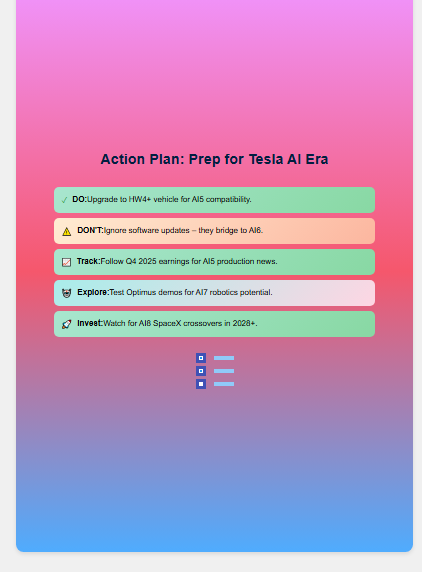
The Path Ahead → An Unavoidable Future?
The Tesla AI5 to AI8 roadmap is a statement rather than merely an update. Elon Musk is betting that driving—and perhaps even intelligence itself—can be solved by processing raw, real-world video footage using enormous, specially designed computers. There are significant obstacles. Public trust, edge-case safety, and regulatory approval are all significant, unresolved issues. However, one thing is certain: We’re not merely witnessing one automaker learn how to improve cruise control. We are witnessing a live and public attempt by a firm to create a new digital brain. None of us can afford to overlook that tale.
How do you feel about Tesla’s AI5 chip production roadmap? Do you think this schedule is realistic for Elon Musk AI8 out of this world and AGI, or is it just a marketing gimmick? Share your thoughts in the comments section below!
